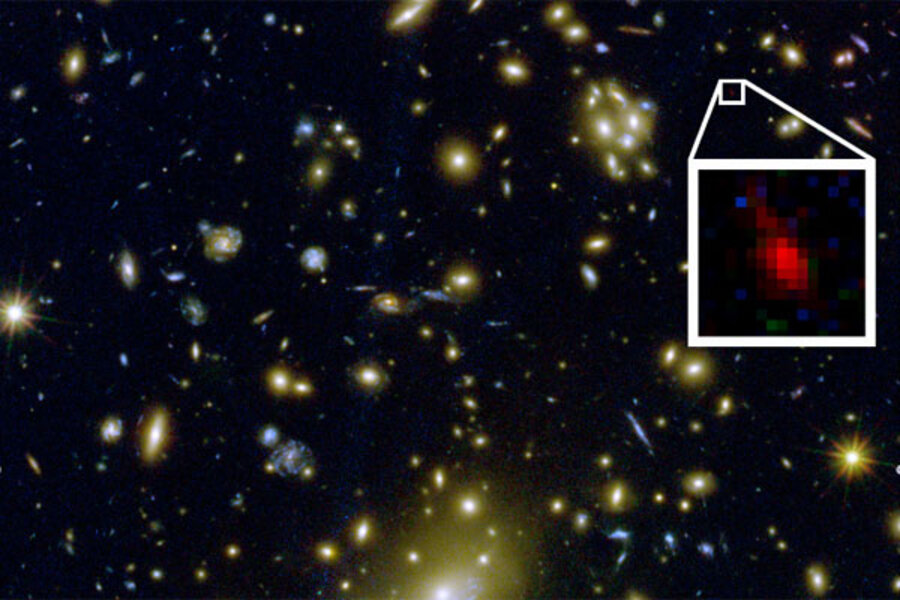Cosmic lens reveals galaxy from the dawn of time
Loading...
The earliest known confirmed galaxy has been discovered with the help of cosmic lenses formed out of the warped fabric of space and time, researchers say.
This distant, ancient galaxy may have once helped clear out the murky fog that once filled the early universe, scientists added.
Astronomers estimate that the universe began about 13.7 billion years ago during the Big Bang. Recent findings suggest the first galaxies formed less than 500 million years after the universe's birth.
Little is known about the earliest galaxies since their light is very faint, given how far away they are. One tool researchers can use to peer at these galaxies are so-called gravitational lenses, magnifying glasses resulting from the warped fabric of reality.
Gravity curves space-time; the greater the mass of an object in space, the stronger its gravitational pull. This, in turn, bends light around it, affecting how telescopes on Earth view it. [Big Bang to Now in 10 Easy Steps]
Astronomers can gauge the age of an object by estimating its distance. Since the speed of light appears the same throughout the universe, knowing how far away an object is reveals how long it took for its light to get here. Scientists can work out the distance of an object by looking at how much the light from it is distorted.
Using gravitational lensing caused by one of the most massive known galaxy clusters, scientists glimpsed a galaxy that existed when the universe was about 500 million years old using two NASA space observatories: the Hubble Space Telescope and the Spitzer Space Telescope.
Based on its level of development, the researchers estimate this galaxy is about 150 million times the mass of the sun and formed less than 200 million years after the Big Bang. This is currently the earliest known and most distant galaxy that scientists have confidently identified.
"We feel like archaeologists with a pre-Neanderthal fossil in hand," lead study author Wei Zheng, an astronomer at Johns Hopkins University, told SPACE.com.
Astronomers have detected potentially older galaxies, but their faintness makes it difficult to make out key details regarding their age.
"Such a discovery would not have been possible if the object was un-lensed," Zheng said.
The age of this galaxy reveals it formed during the so-called "epoch of reionization" that occurred about 150 million to 800 million years after the Big Bang. This critical but still largely mysterious event occurred when intense ultraviolet radiation cleared the fog of atomic hydrogen that once pervaded the cosmos by ionizing it into its constituent protons and electrons.
"This provides us with a unique glimpse of star formation and galaxy growth in the period spanning 300 [million] to 500 million years after the Big Bang," astronomer Daniel Stark at the University of Arizona at Tucson, who did not take part in this study, told SPACE.com. "While caution should be exercised in the interpretation of a single object, the results presented in the Zheng paper point to significant star formation activity throughout this period."
Much remains uncertain as to what sources of radiation caused the epoch of reionization. Since the researchers found this ancient galaxy after only monitoring a small patch of sky, Zheng said the early universe may have overall been rich with galaxies that drove reionization.
The scientists detailed their findings in the Sept. 20 issue of the journal Nature.
Follow SPACE.com on Twitter @Spacedotcom. We're also on Facebook and Google+.







